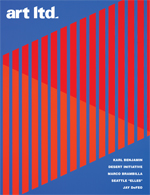May 2012

Installation
View of Prison
2012
Peter Halley
Photo: Mark Stein,
courtesy Disjecta
The space takes no prisoners. At 3,500 square feet,
with a ceiling that vaults 26 feet, the main gallery at arts nonprofit Disjecta
throws down a gauntlet to any artist who would presume to fill it. The challenge
multiplies exponentially should an artist opt to fill only the walls but leave
the expansive concrete floors bare, yet this is exactly what renowned painter
and printmaker Peter Halley did earlier this year with Prison, the sixth
and final installment in Disjecta's inaugural curator-in-residence season.
Halley, a poster child for the Neo-Geo movement of the 1980s-era East Village,
has sustained a career-long obsession with squares, rectangles, and thick
connective lines, which he posits as stand-ins for a host of social and
technological phenomena. In March 2011, the New York artist was approached by
Disjecta's curator-in-residence, Jenene Nagy, to create an installation for the
nonprofit�s barn-sized main gallery. He accepted, intrigued to adapt his
signature geometric syntax to an idiosyncratic structure and delve further into
his lifelong fascination with architecture. "As the 1980s gave way to the '90s,"
he reflects, "I felt that the core issues I was interested in as an artist had
moved into the sphere of architecture. I very much admired the writing of Rem
Koolhaas and a number of others who were addressing the social function of
architecture at the turn of the millennium."
In the past, Halley had
always firmly divided his installation practice into distinct styles. His
painting-based installations stuck to his familiar rectilinear vocabulary, while
his prints featured colorful explosions that seemed to playfully dynamite the
squares and rectangles that established his reputation. But upon considering
Disjecta's layout, he decided for the first time to use the prison motif rather
than the explosions in a print installation. "The fact that the sheetrock walls
are not freestanding but are detached from the physical perimeter wall was an
important part of developing the project. The walls seemed more like a fence
that holds something in than a wall that keeps something out. It seemed almost
like a prison yard."
Over the next few months, Halley and his assistant,
artist Lauren Clay, sifted through compositions from past paintings, composited
them, and enlarged them into sheets of digital prints in acid green and magenta.
Then in late January of this year, the prints were installed in a grouping that
hugged three walls, spanning 175 feet long by 12 feet high. Theater gels threw a
queasy sheen over the stacked prisons, an effect heightened by intense color
bouncing off two partition walls painted DayGlo yellow. These walls, viewed from
afar, appeared to subtly warp in a convex funhouse distortion, while the
hundreds of vertical and horizontal prison bars dizzied the eye with moire
effects. The eye-boggling, hyperchromatic atmosphere filled the hall almost as a
liquid, the Felliniesque sense of carnival balanced by a Bergman-like angst; the
confinement and oppression implied by the relentless prisons and fence-like
walls recalled the specter of concentration camps and Soviet gulags. At the same
time, features endemic to the hall dueted almost whimsically with Halley's
motifs and artistic history. Looming above one wall, the slats of a large
heating vent echoed the horizontal prison bars beneath. Traversing the room's
heights, diagonal and curved Douglas fir beams created visual tensions with the
artist's perpendicular compositions. Finally, protruding awkwardly from a
corner, a drainage pipe seemed to obliquely reference Halley's famous quip
contrasting modernism's transcendental aims with his own decidedly less
grandiose intent: "I took Barnett Newman's 'zip' and turned it into
plumbing."
Prison was unquestionably a shot in the arm for
Disjecta and a milestone for the larger Portland art scene. "Working with an
artist of Peter's caliber was amazing," Nagy says. "He is extremely generous and
runs a tight ship, which I appreciated." The show capped Nagy's tenure; the
program resumes in September with a new curator, unnamed as of press time.
Meantime, Disjecta's "Portland2012: A Biennial of Contemporary Art," curated by
Prudence Roberts, will be followed by summer exhibitions showcasing recent MFA
graduates of the University of Oregon and the Pacific Northwest College of Art.
These are heady times for a once-scrappy nonprofit, founded in earnest in 2000
by executive director Bryan Suereth. If there were any doubt whether times have
changed, it was dispelled by a telling moment at the start of Prison's
run. Halley had donated ten prints for Disjecta to sell, in support for their
curator-in-residence program. The prints were offered at $1,000 apiece, a
bargain for this artist's work but still conceivably outside collectors' comfort
zones in a town notorious for shallow pockets. Would somebody, anybody, pony up
and buy one? That question was as open as whether anyone would have ever dreamed
that Disjecta could survive and thrive here for 12 years and counting. As it
turned out, the prints not only sold; they sold out.

